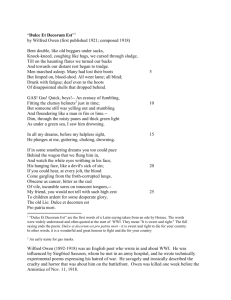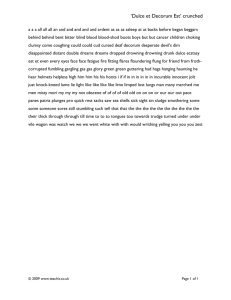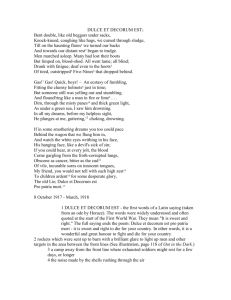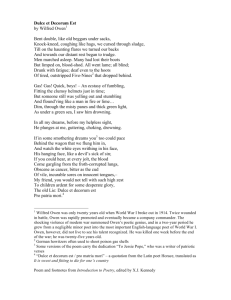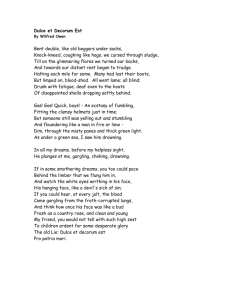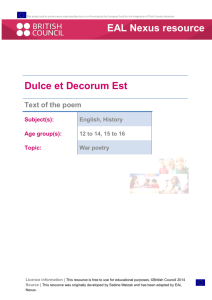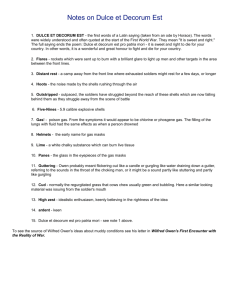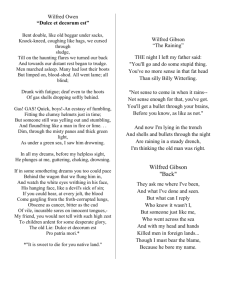“Dulce Et Decorum Est”
advertisement
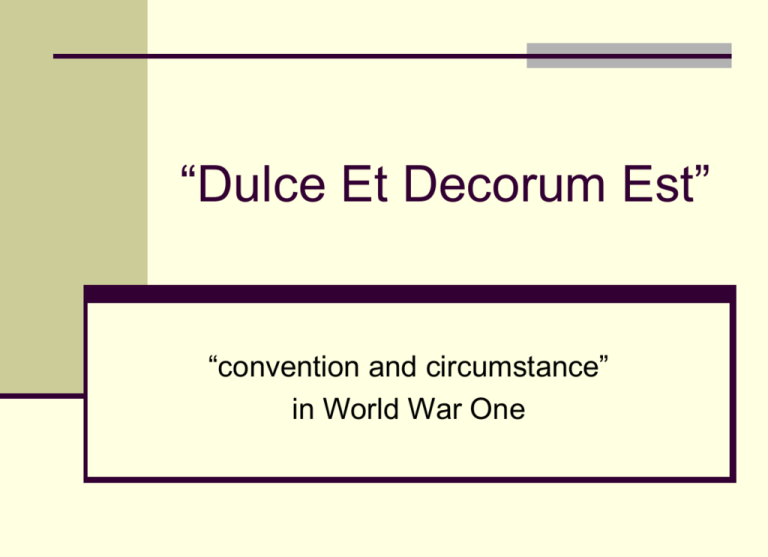
“Dulce Et Decorum Est” “convention and circumstance” in World War One “Paths of Glory” – C.R.W. Nevinson (1917) Dulce Et Decorum Est Bent double, like old beggars under sacks, In all my dreams, before my helpless sight, Knock-kneed, coughing like hags, we cursed He plunges at me, guttering, choking, through sludge, drowning. Till on the haunting flares we turned our backs And towards our distant rest began to trudge. If in some smothering dreams you too could pace Men marched asleep. Many had lost their boots Behind the wagon that we flung him in, But limped on, blood-shod. All went lame; all And watch the white eyes writhing in his face, His hanging face, like a devil's sick of sin; blind; If you could hear, at every jolt, the blood Drunk with fatigue; deaf even to the hoots Come gargling from the froth-corrupted lungs, Of tired, outstripped Five-Nines that dropped Obscene as cancer, bitter as the cud behind. Of vile, incurable sores on innocent tongues,My friend, you would not tell with such high zest Gas! Gas! Quick, boys!-An ecstasy of fumbling, To children ardent for some desperate glory, Fitting the clumsy helmets just in time; The old Lie: Dulce et decorum est But someone still was yelling out and stumbling Pro patria mori. And flound'ring like a man in fire or lime... Dim, through the misty panes and thick green - Wilfred Owen light, As under a green sea, I saw him drowning. “Gassed” – John Singer Sargent (1918) “Dulce Et Decorum Est” 1. At the end of his poem Wilfred Owen speaks of "the old Lie." What is this lie? Why does he consider it a lie? Give illustrations. 2. What is it about the "Lie" that makes him so angry? Explain in one or two concise sentences. 3. What conflicting attitudes and facts at the beginning of World War I does the poem illustrate? 4. Show how "Dulce Et Decorum Est" is a condemnation of all war, as opposed to just World War I. 5. This poem is by an "angry young man" of the early 1900s. Identify and illustrate three methods used by Owen to convey strong emotion. 6. Do you think Wilfred Owen is a sensationalist? Explain. Yes, even for horses… http://inventors.about.com/library/inventors/bl_gas_mask.htm http://inventors.about.com/gi/dynamic/offsite.htm?site=http://www.nofuture.com/lmag/history/wwimasks.htm “Dulce Et Decorum Est” 7. At the opening of the poem some soldiers are returning from a battle, but the poet doesn't say whether it has been won or lost. What is your opinion concerning this point? Justify your ideas. Why does the poet refrain from stating whether the battle has been won or lost? 8. In World War II the use of mustard gas was internationally banned because of the unbelievable suffering it had caused in World War I. Show how Owen's description accurately conveys the effects of this gas upon the soldiers in his poem. 9. With reference to "Dulce Et Decorum Est", show how war degenerates and dehumanizes those who take part in it. “Dulce Et Decorum Est” 10. Comment on the significance of three of the following: (a) An ecstasy of fumbling (b) the clumsy helmets (c) Dim through the misty panes and thick green light, As under a green sea, I saw him drowning. (d) His hanging face, like a devil's sick of sin; (e) children ardent for some desperate glory. 11. Explain how the Latin motto from Horace provides an appropriate ending for the poem. Dressing Station in the Field – Alfred Bastien (p. 366) “Dressing Station in the Field” During World War I, artists such as Alfred Bastien were sent to the front to record the action. Bastien was attached to the famous French-Canadian 22nd Battalion (the Van Doos). Patriotism and support for the war effort were a major focus of news reports and images from the war in many countries. Why do you think the artist chose to paint this scene? What message does it convey? Which aspects of the painting do you find most striking? Explain. recruiting the “children” personal response to texts Consider the themes present in Owen's poem and Bastien's painting regarding the nature of warfare. "What idea does the text creator develop about the significance of an individual's attempt to live unconstrained by convention or circumstance?" Support your idea(s) with reference to ONE of the texts. You may want to review your NOTES on "how to write a visual reflection" before you begin. In your writing you should select a prose form that is appropriate to the ideas you wish to express and that will enable you to effectively communicate to the reader (short essay, rant, conversation, newspaper article, editorial, interior monologue, short story, personal observation, etc.) discuss ideas and impressions that are meaningful to you respond from a personal, critical and/or creative perspective consider how you can create a strong unifying effect
